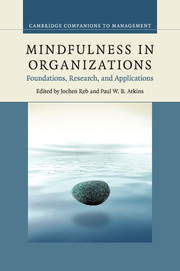Book contents
- Frontmatter
- Contents
- List of figures
- List of tables
- List of contributors
- Foreword
- Preface
- Part I Foundations
- Part II Research
- 6 Mindfulness, identity and work: mindfulness training creates a more flexible sense of self
- 7 Improving decision making through mindfulness
- 8 Mindfulness and creativity in the workplace
- 9 How being mindful impacts individuals' work-family balance, conflict, and enrichment: a review of existing evidence, mechanisms and future directions
- 10 Building and maintaining better leadership relationships through mindfulness
- 11 Leading with mindfulness: exploring the relation of mindfulness with leadership behaviors, styles, and development
- 12 Mindfulness in interpersonal negotiations: delineating the concept of mindfulness and proposing a mindful, relational self-regulation (MRSR) model
- 13 Drawing the line: sketching out the role of visual templates in individual mindfulness and mindful organizing
- Part III Applications
- Index
- References
8 - Mindfulness and creativity in the workplace
from Part II - Research
Published online by Cambridge University Press: 05 July 2015
- Frontmatter
- Contents
- List of figures
- List of tables
- List of contributors
- Foreword
- Preface
- Part I Foundations
- Part II Research
- 6 Mindfulness, identity and work: mindfulness training creates a more flexible sense of self
- 7 Improving decision making through mindfulness
- 8 Mindfulness and creativity in the workplace
- 9 How being mindful impacts individuals' work-family balance, conflict, and enrichment: a review of existing evidence, mechanisms and future directions
- 10 Building and maintaining better leadership relationships through mindfulness
- 11 Leading with mindfulness: exploring the relation of mindfulness with leadership behaviors, styles, and development
- 12 Mindfulness in interpersonal negotiations: delineating the concept of mindfulness and proposing a mindful, relational self-regulation (MRSR) model
- 13 Drawing the line: sketching out the role of visual templates in individual mindfulness and mindful organizing
- Part III Applications
- Index
- References
Summary
Introduction
In the spring of 2010, the technology and consulting organization IBM released a much-publicized opinion study of CEOs. Some 1,500 chief executives from 60 countries and 33 industries suggested that more than integrity, rigor, or even vision, creativity is the single most important leadership competency (Berman and Korsten 2010). Upon reflection, this finding is not entirely counterintuitive as creativity is a key driver of long-term organizational success (Florida, 2002). Far too often, top managers fall into routine and habitual ways of doing business that prevent them from adapting to changing conditions and recognizing new opportunities (Nystrom and Starbuck 1984). Firms such as Polaroid, whose management was wholly unprepared to adapt to the rise of digital photography, richly illustrate this point (Tripsas and Gavetti 2000). As business environments grow increasingly volatile and complex, managers who can navigate ambiguity and respond adaptively to change will be in ever-higher demand.
Yet, despite being of critical importance to firm success, academics and practitioners alike are uncertain how to best facilitate workplace creativity. Existing approaches largely seek to improve creativity either by hiring individuals perceived as particularly talented or by implementing policies and procedures that increase employees' motivation to think creatively. Mindfulness training may represent a third route to creativity. While typically conceptualized as a wellness intervention, mindfulness training was developed by Buddhist monastics to produce a state of mind that “differs profoundly” from “our usual mode of consciousness” (Bodhi 1984, p. 75). This state of mind speaks rather directly to the kind of cognitive flexibility and creative insight required in the modern workplace. As such, I suggest that mindfulness may provide a distinctive intrapsychic path to enhanced workplace creativity. In this chapter, I therefore outline an integrated perspective of creative cognition in light of mindfulness that I hope will be of benefit to academics and practitioners alike.
- Type
- Chapter
- Information
- Mindfulness in OrganizationsFoundations, Research, and Applications, pp. 190 - 212Publisher: Cambridge University PressPrint publication year: 2015
References
- 20
- Cited by



